Web Infantry Equipment, Pattern 1944
N.A.T.O. Stores Coding & Nomenclature
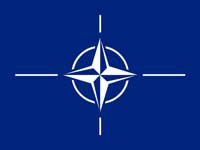 Rather than clutter the component headings – with incredibly long nomenclatures, the following are presented as a separate group. For the most part the components are identical to the wartime issues, but with N.S.N. codes, being of more modern manufacture. However, the group includes new designs of the Belt, the Haversack and both Basic pouches, whose nomenclature changed to Ammunition pouches.
Rather than clutter the component headings – with incredibly long nomenclatures, the following are presented as a separate group. For the most part the components are identical to the wartime issues, but with N.S.N. codes, being of more modern manufacture. However, the group includes new designs of the Belt, the Haversack and both Basic pouches, whose nomenclature changed to Ammunition pouches.
The structure of the North Atlantic Treaty Organisation (N.A.T.O.) was inevitably slanted the way of the U.S.A. With this came an American system of coding and, to an extent, terminology. Other than odd and un-explained uses of N.A.T.O. Stores Numbers (N.S.N.), as early as 1958, the British Armed Forces were slow to take these up, Patt. ’58 W.E. examples dating from 1965. When they did, they simply used the CCN / COSA Sections (themselves reincarnations of VAOS). Thus NSNs were often prefixed with “CN”. They were also presented in whole (13 digits) or just the “last seven”, which was the NATO Item Identification Number (NIIN)
The C.O.S.A. is a three column layout, N.S.N., ITEM and DETAIL. The quality of understanding, by modern MoD clerks, is quite woeful, as is their rendition of plain English – punctuation (too much, too little, or just plain incorrect), lack of capitals, syntax, etc. The ITEM varies from cryptic to copious and the Pattern Year, if used, is found in DETAIL – mostly, but not always. For clarity, ITEM is here shown in bold. The reader is left to marvel at the idiosyncrasies and inconsistencies and the peripatetic nature of the Pattern Year.
An Issue 2 Haversack, illustrated in this section, has a Sealed Pattern date of 12th April 1965. It also only has N.S.N. codes on the label. It is assumed, therefore, that the Issue 2 forms of Belt and Basic pouches were sealed at the same time.
Stores Ref. CN/8465-99-973-6175
ATTACHMENT, BRACE
Used on Web Equipment 1944 Pattern
Stores Ref. CN/8465-99-973-6176
BELT, WAIST, Olive, drab, 33 in. min to 50 in. max lg 2 in. w
Adjustable large; used on Web Equipment; 1944 Pattern
Stores Ref. CN/8465-99-973-6177
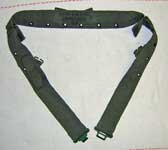
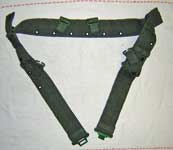
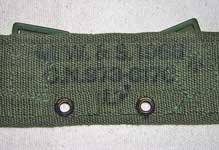 The belt shown left, from the Karkee Web Collection, is maker marked "M.W. & S. Ltd." and dated 1968. It has the standard large size 973-6176 code, not the 973-6258 code listed below, but the webbing is much heavier than normal Patt. '44 Belts, and is at least as heavy as what you'd expect to see on a Patt. '37 Belt. The Detail in the COSA ought therefore to have been Adjustable large; (modified pattern); heavy webbing; used on Web Equipment; 1944 Pattern. This inconsistency of approach is par for the course in COSA editions!
The belt shown left, from the Karkee Web Collection, is maker marked "M.W. & S. Ltd." and dated 1968. It has the standard large size 973-6176 code, not the 973-6258 code listed below, but the webbing is much heavier than normal Patt. '44 Belts, and is at least as heavy as what you'd expect to see on a Patt. '37 Belt. The Detail in the COSA ought therefore to have been Adjustable large; (modified pattern); heavy webbing; used on Web Equipment; 1944 Pattern. This inconsistency of approach is par for the course in COSA editions!
Of more interest is 8465-99-973-6177, a code not listed in COSA, whose sequence jumps from -6176 to the water bottle at -6178.This is a coding drop-off by MoD clerks, the gap being for the heavier webbing form of the Belt, normal. However, this code does appear in UK CRL NIIN SEQ, a fiche form of the UK Control Reference List – NATO Item Identification Number Sequence. In one column of this layout, cross-reference is made to older Army CN codes and to R.A.F. codes in their Vocabulary, A.P. 1086 Section 23. For -6177, an additional code appears, 23-388, which is the R.A.F. code for a Belt, normal.
If the clerks had thought about it, the new heavier weight Belt, normal, coded 8465-99-973-6258 should have taken the spare code intended for it!For the first issue variations of the Belt, please go to the W.E. Patt. '44 Belts, Braces, and Straps page.
Stores Ref. CN/8465-99-973-6178
CANTEEN, WATER, Aluminium, 1 qt capacity
Without cover; complete with cap; screwed and aluminium cup, 1944 Pattern; web equipment
The wartime Canteen, changed quickly to Bottle, has now re-appeared, re-arranging the Army alphabet as A, C, B, etc!! The bottle, cup and carrier having once been grouped, remained so, with sequential codes ahead of the “B” section. This reckoned without a later decision to catalogue the Cap as well, which appears last in the items below.
Stores Ref. CN/8465-99-973-6179
CARRIER, WATER CANTEEN, webbing
Olive green; with one compartment
Not only no Detail, but no Pattern Year either!
Stores Ref. CN/8465-99-973-6180
CUP, CANTEEN, aluminium
With stainless steel butterfly handle; 1944 Pattern; web equipment
Stores Ref. CN/8465-99-973-6181
BRACE
Used on Web Equipment; 1944 Pattern
They are a pair – where is the plural?
Stores Ref. CN/8465-99-973-6182
CASE, BINOCULAR; 1944 Pattern; web equipment
No Detail
Stores Ref. CN/1095-99-973-6183
HOLSTER, PISTOL, Flat type, Olive drab
Quick release; used on web equipment; 1944 Pattern
Note the change from the archaic Case to a Holster, which puts this out of sequence
Stores Ref. CN/8465-99-973-6184
FROG, BAYONET, 1944 Pattern
No Detail
Stores Ref. CN/8465-99-973-6185
HAVERSACK, All ranks, 11 in. lg 6.1/2 in. w, 14 in. h
Cotton webbing; olive drab web equipment 1944 Pattern all ranks
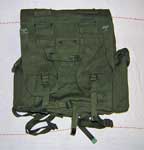
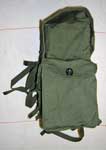
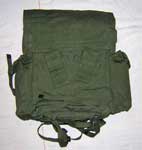
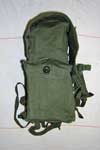 This is the larger design, the pattern being sealed on 12th April 1965. The original issues were approximately 8 x 6 inches and 10 inches deep. The wartime design was secured by QR fasteners, but the side pockets now close with Fasteners, turnbutton, black. The angled buckles above the pockets were still fitted, allowing for attachment to the Brace ends. The greatly increased area of flap was given a sewn-in crease, just below which a transverse “C” clip was stitched. Above the clips, a pair of transverse straps loops were placed on the “top” of the flap, with two further pairs below the hooks. Cross straps, in imitation of the Supporting straps of Patt. ’37, were stitched to the flap edge. These were aligned to cross and then fasten to separate base buckles. They served for extra load carriage, e.g. the steel helmet and were not part of any load balancing feature. On the underside of the flap, in-line with the highest strap loops, there was a short tab strap. This could be connected to a small buckle located on the upper face of the Haversack, under the flap. It served to close the Haversack, if the void above the weather flaps was not filled. However, the QR buckles on the flap mated awkwardly with the straps intended to secure the flap, still leaving the flap as a loose fit over the body, proper, of the Haversack. The example shown left is from the Karkee Web Collection. It is maker marked "M.W. & S. Ltd." and dated 1967.
This is the larger design, the pattern being sealed on 12th April 1965. The original issues were approximately 8 x 6 inches and 10 inches deep. The wartime design was secured by QR fasteners, but the side pockets now close with Fasteners, turnbutton, black. The angled buckles above the pockets were still fitted, allowing for attachment to the Brace ends. The greatly increased area of flap was given a sewn-in crease, just below which a transverse “C” clip was stitched. Above the clips, a pair of transverse straps loops were placed on the “top” of the flap, with two further pairs below the hooks. Cross straps, in imitation of the Supporting straps of Patt. ’37, were stitched to the flap edge. These were aligned to cross and then fasten to separate base buckles. They served for extra load carriage, e.g. the steel helmet and were not part of any load balancing feature. On the underside of the flap, in-line with the highest strap loops, there was a short tab strap. This could be connected to a small buckle located on the upper face of the Haversack, under the flap. It served to close the Haversack, if the void above the weather flaps was not filled. However, the QR buckles on the flap mated awkwardly with the straps intended to secure the flap, still leaving the flap as a loose fit over the body, proper, of the Haversack. The example shown left is from the Karkee Web Collection. It is maker marked "M.W. & S. Ltd." and dated 1967.
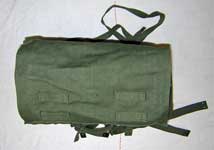
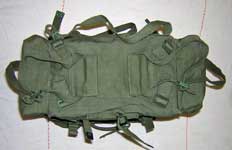 Top (far left) and bottom (near left) view of the Haversack shown above.
Top (far left) and bottom (near left) view of the Haversack shown above.
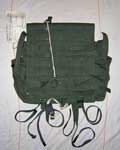

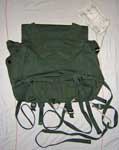
 A sealed pattern example of the 2nd issue Haversack, all ranks, from the Karkee Web Collection. This example is maker marked "M.E. Co." and dated 1965.
A sealed pattern example of the 2nd issue Haversack, all ranks, from the Karkee Web Collection. This example is maker marked "M.E. Co." and dated 1965.
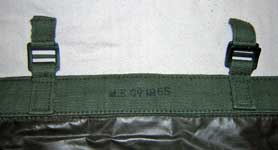
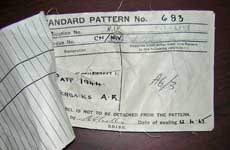
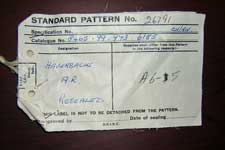 Marking detail (far left) and views of the sealed pattern label.
Marking detail (far left) and views of the sealed pattern label.
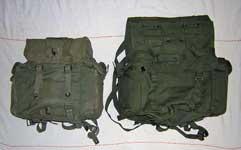 A comparison of the 1st (left) and 2nd (right) issue Haversacks, all ranks. The 2nd issue Haversack is the 1967 dated one shown above, whilst the 1st issue example, also from the Karkee Web Collection, is dated 1946 and maker marked either "D.C. Ltd." or D.G. Ltd.".
A comparison of the 1st (left) and 2nd (right) issue Haversacks, all ranks. The 2nd issue Haversack is the 1967 dated one shown above, whilst the 1st issue example, also from the Karkee Web Collection, is dated 1946 and maker marked either "D.C. Ltd." or D.G. Ltd.".
Word to the wise – this is absolutely NOT the Patt. ’44 Rucksack, nor is it a Patt. '44 "Large pack". Sorry!
For the first issue of the Haversack, please go to the W.E. Patt. '44 Haversacks and Rucksacks page.
Stores Ref. CN/8465-99-973-6186
HAVERSACK, Officers, 13 in. lg, 2 in. w,8.1/2 in. h
Cotton webbing; olive drab
No mention of the Pattern it was intended for!
Stores Ref. CN/8465-99-973-6187
POCKET COMPASS, 1944 Pattern
Used on web equipment
Stores Ref. CN/8465-99-973-6188
POUCH AMMUNITION, 1944 Pattern, Pistol
No Detail
Stores Ref. CN/8465-99-973-6189
POUCH AMMUNITION, 1944 Pattern, Left
No Detail
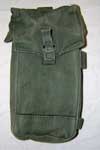


 These are the new design, fitted with two pairs of “C” clips, so that carriage on the Waist belt can be high, or low. In addition a 2-inch wide piece of webbing forms a belt loop over the lower pair and a longer loop, reaching over the upper hooks and attached near the top of the pouch. This allows a very low carriage, more on the lines of Patt. ’58 W.E. The vertical loops for the Haversack waist / chest strap were deleted, the upper belt loop now serving in this function. Scabbard loops are fitted, as in the 1st Issue Pouches. The nomenclature of Basic pouch has been lost, in order to group all Pouches, ammunition in the C.O.S.A. layout. The example shown here is from the Karkee Web Collection. It is maker marked "M.E. Co." and dated 1966.
These are the new design, fitted with two pairs of “C” clips, so that carriage on the Waist belt can be high, or low. In addition a 2-inch wide piece of webbing forms a belt loop over the lower pair and a longer loop, reaching over the upper hooks and attached near the top of the pouch. This allows a very low carriage, more on the lines of Patt. ’58 W.E. The vertical loops for the Haversack waist / chest strap were deleted, the upper belt loop now serving in this function. Scabbard loops are fitted, as in the 1st Issue Pouches. The nomenclature of Basic pouch has been lost, in order to group all Pouches, ammunition in the C.O.S.A. layout. The example shown here is from the Karkee Web Collection. It is maker marked "M.E. Co." and dated 1966.
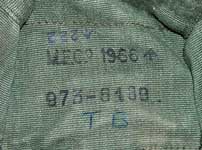
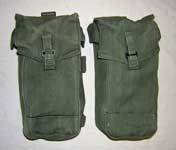
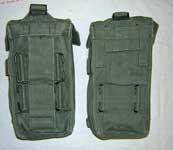 Far left, stamping detail from the Pouch shown above, inside the lid. Centre and near left, the Pouch shown above, compared with a first issue Pouch from the Karkee Web Collection, which is maker marked "M.E. Co." and dated 1945.
Far left, stamping detail from the Pouch shown above, inside the lid. Centre and near left, the Pouch shown above, compared with a first issue Pouch from the Karkee Web Collection, which is maker marked "M.E. Co." and dated 1945.
For the (first issue) Pouch, basic, left, please go to the W.E. Patt. '44 Equipment and Equipment Carriers: Basic Pouches page.
Stores Ref. CN/8465-99-973-6190
POUCH AMMUNITION, 1944 Pattern, Right
No Detail



 As 8465-99-973-6189, but without the scabbard loops. The example shown here is from the Karkee Web Collection. It is maker marked "M.E. Co." and dated 1966.
As 8465-99-973-6189, but without the scabbard loops. The example shown here is from the Karkee Web Collection. It is maker marked "M.E. Co." and dated 1966.
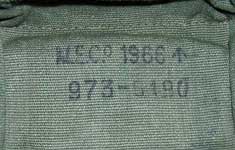
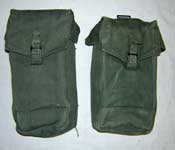
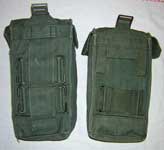 Far left, stamping detail from the Pouch shown above, inside the lid. Centre and near left, the Pouch shown above, compared with a first issue Pouch from the Karkee Web Collection, which is maker marked "M.W. & S. Ltd." and dated 1945.
Far left, stamping detail from the Pouch shown above, inside the lid. Centre and near left, the Pouch shown above, compared with a first issue Pouch from the Karkee Web Collection, which is maker marked "M.W. & S. Ltd." and dated 1945.
For the (first issue) Pouch, basic, right, please go to the W.E. Patt. '44 Equipment and Equipment Carriers: Basic Pouches page.
Stores Ref. CN/8465-99-973-6191
POUCH AMMUNITION, 1944 Pattern, MT Drivers
No Detail
Stores Ref. CN/8465-99-973-6192
STRAP, SHOULDER HAVERSACK, Left
1944 Pattern; web equipment
Stores Ref. CN/8465-99-973-6193
STRAP, SHOULDER HAVERSACK, Right
1944 Pattern; web equipment
Stores Ref. CN/8465-99-973-6202
CAP, CANTEEN, WATER, Stainless steel
Complete with loop for cord; for use with Canteen, Water 8465-99-973-6178
An afterthought – everything that can be separated must be separately coded!!
Stores Ref. CN/8465-99-973-6258
BELT, WAIST, Olive, drab, 30 in. min to 40 in. max lg 2 in. w
Normal; (modified pattern); heavy webbing used on web equipment; 1944 Pattern
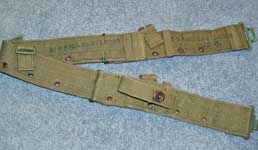
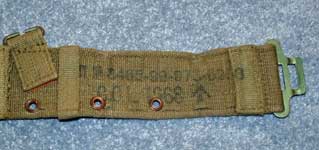 The Belts of U.K. web patterns were often worn on their own, for drill, parades, walking out and, in the case of Patt. ’44, to keep the J.G. Trousers / Shorts up! In consequence, they experienced very heavy use, compared to all the other components, and this was made all the worse for being used as a tropical “theatre issue”. It would seem that this design was introduced to obviate the problem. The higher N.S.N. shows that it was introduced after the Patt. ’44 N.S.N. sequence was allocated. It was identical to the 1st issue Belts, but of a much heavier weave. This example is maker marked "C.C.L." and dated 1968. From the Allen Prior Collection, photographs © Allen Prior 2010.
The Belts of U.K. web patterns were often worn on their own, for drill, parades, walking out and, in the case of Patt. ’44, to keep the J.G. Trousers / Shorts up! In consequence, they experienced very heavy use, compared to all the other components, and this was made all the worse for being used as a tropical “theatre issue”. It would seem that this design was introduced to obviate the problem. The higher N.S.N. shows that it was introduced after the Patt. ’44 N.S.N. sequence was allocated. It was identical to the 1st issue Belts, but of a much heavier weave. This example is maker marked "C.C.L." and dated 1968. From the Allen Prior Collection, photographs © Allen Prior 2010.
For the first issue variations of the Belt, please go to the W.E. Patt. '44 Belts, Braces, and Straps page.